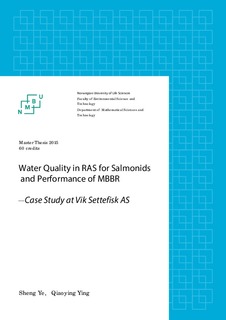| dc.description.abstract | The purposes of this study was to find out water quality variation at Vik Settefisk AS, a land-based commercial smolts farm located in Bergen. In addition, the aim of the study was to evaluate nitrification efficiency in moving bed biofilm reactor (MBBR), disinfection efficiency of ozonation and UV irradiation, and to evaluate whether turbidity could produce a satisfactory estimate of total suspended solids.
There were four tests carried out during the study. Water samples were collected at different sites in the water treatment part. Measured parameters were temperature, pH, dissolved oxygen, alkalinity, NH4-N, NO2-N, NO3-N, COD, turbidity, total suspended solids and heterotrophic bacteria count.
The results showed there were significant declines in TAN, free ammonia, COD concentration and turbidity in reused water after treatment (P<0.05). Suspended solids concentration in test 3 and 4 were lower than in test 1 and 2. High TAN concentration was observed in test 2 due to overfeeding, which was 16.32±0.17 mg/L at site 3.
MBBR functioned effectively in nitrogenous waste removal. COD/TAN ratio was low and stable in test 2 (ranged from 3.92±0.03 to 4.09±0.02). While in other tests, COD/TAN ratio surged from site 3 to 6, especially between site 5 and 6. The highest areal TAN removal rate (0.513±0.186 g/m2.d) was observed in test 2.
In general, chamber 1 had higher efficiency in areal TAN, NO2-N and COD removal rate than chamber 2. However when regarding percent TAN reduction, more TAN was removed in chamber 2 (41.62±1.81% to 59.58±3.71%) than in chamber 1(10.30±1.12 % to 30.53±7.45%), except in test 2. This was because chamber 2 had lager surface area than chamber 1 (58571 m2 compared to 17677 m2), and water had two-times longer retention time in chamber 2.
Make-up water had low heterotrophic bacteria count, which ranged from 4.7±2.5 to 60.0±35.6 CFU/mL before treatment. However, not even a 1-Log10 (90%) reduction was achieved in make-up water after ozone and UV treatment. In reused water, the result showed no significant decline in the heterotrophic bacteria count, the value ranged from 366.7±499.7 to 3633.3±793.0 CFU/mL after ozonation.
There was strong positive correlation between TSS concentration and turbidity in a log-linear model (R2 =0.917), with a regression equation of TSS = 15.46 ln (NTU) -8.4207. It suggested that turbidity could be used as a proxy for TSS in this study. | nb_NO |

